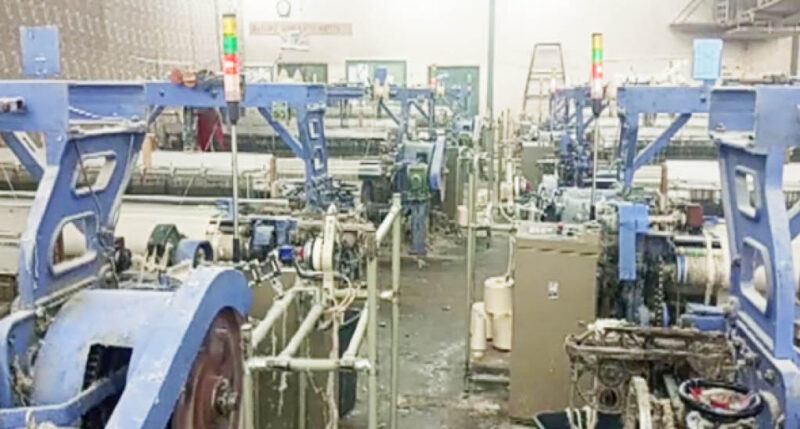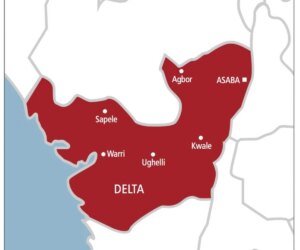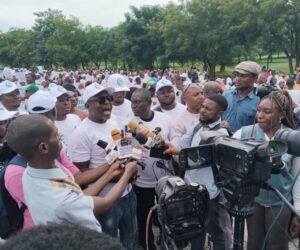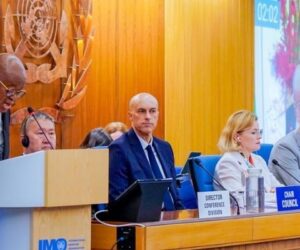Over the years, there have been several efforts to revive the textile industry, which employed about 750,000 workers and contributed 25 per cent to the country’s Gross Domestic Product (GDP) in the 1980s.
Some of these revival strategies include the N100 billion Cotton, Textile and Garment (CTG) fund created in 2009 released by the federal government to the Bank of Industry to revive the moribund industries.
However, 16 years after the establishment of the N100 billion fund, the textile factories remained dormant, with many of them under lock and key and more than 500,000 jobs lost.
SPONSOR AD
In another move in April this year, the National Economic Council (NEC), headed by Vice President Kashim Shettima, approved the establishment of a Cotton, Textile and Garment Development Board, alongside new strategies for agribusiness expansion and livestock transformation projected to generate up to $90 billion in economic value by 2035.
Currently, “only about two composite textile mills are operational at a very low capacity utilisation from more than 180 mills. Only about 12 ginning companies are operating below installed capacities from 52, the same story across the downstream of the value chain,” the president of the National Cotton Association of Nigeria (NACOTAN), Mr Anibe Achimugu told Weekend Trust on Wednesday in Abuja.
However, cotton production, which is a key element of the revival, has not received the require boost that will sustain the textile value chain.
The country has about 650,000 hectares available for cotton farming, but only a third is currently being exploited,
Cotton output collapsed from 300,000 tonnes, which contributed 25 per cent to the GDP in the 1980s to 15,000 tonnes currently, according the NACOTAN.
The number of farmers also slummed from 620,000 in the early 1980s to barely 100,000 farmers in major cotton-producing states, comprising Katsina, Gombe Zamfara, Borno, Adamawa Kaduna, Niger, Oyo and Ogun struggling to feed the small number of ginneries across the country.
Currently, production is largely unorganised, which has created a negative impact on the productivity level and fibre quality.
In the 2019/2020 growing year under the federal government’s Anchor Borrowers Programme, production witnessed a significant increase to about 120,000 tonnes and 136,000 metric tones in the 2020/2021 season.
However, in 2022/2023, because there was no government programme supporting the crop production, the yield dropped to less than 27,000 metric tonnes and further declined to as low as 15,000 tonnes in the 2024/2025 season, according to NACOTAN.
This is stemming from the cessation of any form of intervention to farmers, insecurity, high cost of inputs, very poor quality and insufficient quantity of planting seeds, poor prices and weak demands, just to mention a few.
Yields dropped from 1.5 to 2 tonnes per hectares to an average yield of just 500 to 600 kilograms per hectare.
In an interview with Trust TV A, a development economist, Dr Sambo Ingawa spoke on the significant link between cotton production and textile industries, noting that you cannot separate the two.
“The cotton and textile we inherited from colonial days continued to grow. It held a lot of promise for the future. It fed the cotton industry that was producing competitively, creating surplus and was beginning to feed into textile upper value chain – ginning, textile and export in particular. These things were growing” he said.
The development consultant, however, said that in the 1980s, the situation began to change, which brought down cotton production. He added that oil boom started from 1972 when “Nigeria began to have access to free money from oil and everything began to go South till date.”
Cotton production decline deepens
The textile industry depends on cotton, but production has collapsed in many parts of northern Nigeria.
“Number one is insecurity. I recently travelled from Funtua to Zamfara, but believe me; I couldn’t find a single cotton farm. It has now all turned to soybeans,” Ibrahim Mu’azu Isah, the Head of Human Resources and Public Relations, Funtua Textiles said.
He also said that in many farming areas, bandits stopped people from planting anything, adding, “So, definitely you are going to have shortage of cotton. It is only probably the Gombe area that you can get enough cotton. Even at that, I am not sure.”
Saying that seed quality is another major problem, he explained, “Most of the major seeds have been contaminated, so it doesn’t germinate properly. We need seed revival. We also need to stop insecurity. Most cotton farmers are discouraged now, so we don’t even have many of them.
“If you (farmer) know that you are going to be killed or kidnapped, you won’t even think of going to farm.”
Comparing Nigeria’s situation to that of Egypt, he noted, “They have 9 types of cotton seedling. Each region has its own type. Once they find contamination in one area, they automatically condemn all the seeds in that area that year, change it and give them a new one. But here, we don’t have that.”
He urged the federal government to fund the research centres so as to produce quality cotton seeds for farmers in the country.
Lamenting the state of cotton production, Samuel Oloruntoba, the acting managing director of Cotton Ginning Company Limited, Kaduna said,
“It is very pathetic. Actually, cotton production is no longer there. We are a cotton engineering company and our factory is located in Malunfashi, Katsina State. Our labour in Katsina is really good, but presently, it is on the low side due to a number of factors.”
He mentioned insecurity and poor seeds as the main reasons farmers abandoned cotton.
“The seeds we have today are not good enough – the yield is bad and that has made farmers to stop producing cotton. So, for us to revive the cotton industry, we must look at the seeds.
“We must get better-yielding seeds. Our research institutes need to be properly funded to produce good seeds. The current seeds are bad. Secondly, the issue of insecurity is very key. The situation is pathetic in Katsina and Zamfara, so to say. Just last week, bandits attacked the community around our factory. It has been a very bad situation. Security needs to be addressed.
“The issue of seeds and good yield needs to be improved. Farmers are no longer directly producing cotton, so they need to be sensitised.
“We need to be facilitated, given seeds and what I call inputs. Cotton needs chemicals, without which it will not produce. So they need to be provided with chemicals and seeds. They also need to be funded,” he said.
Oloruntoba also said the cotton market must be restored, adding, “The textiles we used to have are not here now. The market is very crucial. We need to encourage farmers to produce cotton by giving them support. If you revive at least two textile mills in Kaduna you would give farmers a reason to grow cotton again.”
Alhaji Munzali Dayyabu Taura, the national vice president of the National Cotton Association of Nigeria (NACOTAN), said it’s unfortunate that cotton had not been produced as expected in recent years due to poor attention given to the sector by both the public and private sectors over the years.
He explained that cotton was included at the tail end of the Anchor Borrower Programme before it was halted.
Progress in Adamawa, Gombe but…
Despite Adamawa’s reputation for having the country’s most fertile soil for cotton, the chairman of the Cotton Farmers Association in the state, Alhaji Aliyu Saleh Gwalam, said lack of government’s interest and investment was stifling the industry’s immense economic potential.
Gwalam urged the state government to make investments in the cotton industry, pointing out that there are between 5,000 and 6,000 growers spread across 19 of the state’s 21 local government areas. He cautioned that the state might not even be aware of how successful its cotton output is.
Prominent villages known for the production of cotton include Gwalam in Numan, Kem in Shelleng and Lafia-Lamurde in Lamurde local government areas, Maiha, Gudu, Chikka and Banjiram in Guyuk etc.
Gwalam noted the superior quality of Yola cotton, saying it has the best thread.
“Our state is known for producing the best in the country. Adamawa is one of the few states where a good number of local government areas plant and produce cotton massively, thanks to the fertile land,” he said.
He also said buyers tend to hoard cotton during the November-December sales, which is the peak season in the state.
According to him, instability in the exchange rate of the naira has an impact on the price of cotton. He added that currently, they are marketing it at a lower price than what it was previously.
He said, “The instability of the dollar has a ripple effect on the non-oil sector, impacting prices of goods like cotton. We are now selling at a price lower than before. It is to be expected. It is a difficulty we have encountered; but hopefully, with the help of government’s intervention, we will overcome this.”
Farmers once sold a tonne (1,000 kg) between N600,000 and N700,000, but current instability has driven the price down to N400,000 and N500,000. The market typically booms from November to December, sometimes extending to March.
He urged the state and the federal government to support cotton farmers with seedlings and tractors.
“We can improve our productivity and quality of cotton if we are given good seedlings. We need a tractor to plough fields, especially during the rainy season when sowing cotton trails.
“I would not be surprised if the state government claimed they did not know we were still producing cotton. There has never been a day we were called to receive any state intervention as an association,” he said.
To truly boost productivity, Gwalam appealed for support in two key areas of quality seedlings and tractors.
He specifically praised a “Mahyco” seedling from India, which he described as pest-resistant and of high quality.
“Without good seedlings, no matter the size of the farm, it is a complete waste of energy, time and resources.
“If the state truly understood the importance of cotton, it would have invested in it long ago,” he added, saying that if supported, a farmer could produce up to 9 tonnes from three hectares of land, potentially leading to a total output of 45,000 tonnes for the state.
He appealed to the state and the federal government to buy and revive the AFCOT Indian Company, which he believes would create thousands of jobs, reduce hardship and serve as a catalyst for a robust agricultural economy.
The Commissioner for Agriculture in Adamawa State, Mr David Finchiwa
Jatau, said most cotton farmers operated at an individual level, noting that the state does not have a cotton farm of its own.
“We do not have the programme yet, so only individuals engage in cotton production,” he said.
On whether there are plans to assist cotton farmers boost the state’s internally generated revenue, he said, “Nothing for now, maybe soon.”
In Gombe State, the deputy national president of the Cotton Producers and Merchants Association of Nigeria (COPMAN), who is also the national secretary of the Cotton Farmers’ Cooperative Society Limited, as well as COPMAN chairman for Gombe State and the North-East, Alhaji Sadiq Ado, said reviving cotton farming would bring the state’s dormant ginning industries back to life.
Speaking in Gombe, the state capital, Ado recalled that between 2012 and 2020, cotton farming in Nigeria experienced a significant growth, with raw cotton processed at the Nasara Agro Ginning Company, an achievement he attributed to the support of the Anchor Borrowers’ Programme under the administration of former President Muhammadu Buhari.
However, he said production declined after the government withdrew financial support in Adamawa, Taraba, Yobe and Gombe states.
He, however, noted that despite this, some well-funded farmers sustained production, but stressed that renewed and broader support is needed, saying preparations were already underway for the establishment of the Cotton, Textile, and Garment Development Board under the Office of the President.
Ado noted that the board, which was approved by the federal government during a National Economic Council meeting chaired by Vice President Kashim Shettima, with all 36 governors in attendance, would unite investors, farmers, traders, dyers and cottonseed oil processors to strengthen the entire value chain.
“Farmers need more than seeds; they require guaranteed markets, fair pricing and improved security to prevent farmers-herders clashes,” he said.
The public relations officer of the Cotton Farmers Association in Gombe State, Bala Lawan Garba, also confirmed that the sector had suffered a decline in recent years due to low prices. He, however, noted that improved early-maturing seed varieties and recent government’s interventions were reigniting optimism.
Between 2020 and 2024, he said there was no structured support for cotton farmers until recently when the national body of cotton farmers assisted 5,000 and the Gombe State Government supported 750 more with inputs supplied through partnership with companies from Chad and Cameroon.
Garba said market prices improved significantly, rising from N350 per kilogram (N350,000 per tonne) in previous years to N750 (N750,000 today.
He attributed part of this increase to a decline in sesame production, which previously diverted farmers from cotton.
He further disclosed that Gombe has four ginning factories – Wacot, Nasara Agro Industrial Company, CFA Gombe and CFA Shabbal in Kumo, but only Wacot is currently operational.
He called on the government to distribute seeds early each season and advised farmers to work closely with agricultural extension officers.
A retired agricultural extension officer, who is also a cotton farmer, Alhaji Gidado Abubakar Kwadom, stressed that farmers should follow professional guidance to improve yields and explore dry-season farming, which he said could be more profitable than rainy season cultivation for those who missed early planting.
He also called for a textile factory to be established at the Muhammadu Buhari Industrial Park to strengthen cotton value chain in Gombe.
Meanwhile, an official of Nasara Agro Company, Aliyu Umar, said the firm had been inactive for two years due to electricity shortage, high operational cost and insufficient cotton supply.
Declining cotton production halts textile revival
The value of Nigeria’s cotton industry in 1980 was N8.9 billion, about 25 per cent of the country’s GDP. Regrettably, it fell to just N300 million in 2012,
From the 1960s to the late 1980s, about 180 textile industries were active in the country. Kaduna, Kano and Katsina witnessed a massive influx of graduates and unskilled labourers who sought and got jobs in these industries.
About 50 ginneries existed in Nigeria at the time, but only 19 of them are still in operation today. And they are only using a small portion of their capacity.
Today, most of these industries are no more. Inadequate cotton production by farmers, government’s indifference and the importation of textile materials hobbled those who are able to breathe.
Sad tale of textile industries in Kaduna
Many ex-workers recalled how the sound of machines filled the air in Kaduna’s industrial areas, where textile factories worked day and night, producing fabrics that clothed millions and provided jobs for tens of thousands of people. Today, those buildings are mostly silent. In some, the only movement comes from snakes and other reptiles that now live where workers once stood at the looms.
Comrade Jeibe Wordam Simdik, the chairman of the Workers’ Board of Trustees at Kaduna Textiles Limited (KTL), who joined the company in 1979 when the industry was still booming said, “At that time, Kaduna State had about 11 textile mills with a combined workforce of over 50,000 employees. KTL alone employed more than 6,000 workers. The industry didn’t just produce fabrics, it created entire communities.”
He said that neighbourhoods like Nasarawa, Makera, Kakuri, Television, Kudenda, including part of Barnawa, were built around textile workers’ salaries.
Simdik noted that on payday, markets around the factories came alive as women and men sold goods at the factory gates. It created business for thousands of households.
He said the decline began after 1999 when Nigeria opened its markets to cheap foreign textiles, adding, “The influx of imported textiles crippled local production. “KTL closed in 2002 with over 3,000 workers. Arewa Textiles closed in 2004 with more than 2,200 workers. Supertex and Fine Textiles closed in 2003 with 1600 workers.”
Today, only Chellco Industries Limited, privately-owned and run by a foreigner, still operates in Kaduna with less than 600 workers.
He also said, “Over 630 former KTL workers have died without receiving their gratuities and other benefits. The situation for surviving ex-workers is dire. We buried an ex-worker recently; and next week, we are going for another wake-keep for another of our late staff.”
One of the biggest names in Nigerian textiles in Kaduna was the United Nigerian Textiles Limited (UNTL) established in 1964. By the 1990s, it was the largest textile group in West Africa, producing more than 100 million metres of fabric every year and employing nearly 14,000 workers across the region.
The industry owned spinning mills, weaving plants and finishing factories. It sourced cotton from Nigerian farmers and trained skilled textile technicians.
At the invitation of the then North-Central State Government (now Kaduna State Government), Funtua Textiles Limited, another subsidiary company, was established at Funtua (now in Katsina State) in 1978.
The factory was designed to produce bed-sheets and pillowcases, thereby diversifying the group’s range of products.
The UNTL later acquired a site and established two new factories in 1981 and 1982 respectively. One was a subsidiary company named Unitex Limited while another was an associated company named Supertex Limited. Unitex is purely a spinning mill, whereas Supertex is a finishing plant with the capacity of producing popular wax fabrics.
But the rise of smuggled foreign fabrics, high production cost and poor infrastructure forced the company to shut down in 2007. It reopened in 2010 but never regained its former strength.
Machines are silent in Kano too
Like Kaduna, Kano State, which once served as a hub of textile industries with over 10 functional textile industries, also went silent. Most of these textile firms have become moribund.
From the late 1970s to early 1980s, Kano State has been a home to textile companies like Gaskiya Textile, Universal Textile, Angel Spinning and Dyeing Limited, Kano, African Textile Manufacturers Limited, Bagauda Textile, Adhama Textile and Holborn Nigeria Limited, among many others that are currently not in existence or closed down under liabilities.
However, few others still operate on demand whenever they get a production contract, especially during election period.
Malam Danladi Ya’u, an employee of the shutdown Gaskiya Textile said the death of the owner of the company, Alhaji Nababa Badami, cost of production, lack of favourable government policies and competition between Nigerian-made textile products and cheap imported textile products, coupled with lack of electricity and access to cotton, were some of the factors that contributed to the suffocation of Gaskiya Textile.
“The collapse of this company has directly rendered more than 2,000 staff jobless, as well as over 3,000 indirect employees. In 2018, the Nigerian Textile Manufacturers Association revealed that more than 100,000 jobs had been lost in 25 years due to the closure of textile industries across the nation. You can imagine what that means to a country like Nigeria, and that has given room for importation instead of reviving the already existing ones,” Malam Danladi said.
Factories in ruins as optimism wanes
Weekend Trust reports that most of the factories have now become historical relics. KTL’s buildings are stripped of roofing sheets, doors and windows.
Our correspondent was told that only snakes and other dangerous reptiles are found in the premises, while it has become a hidden place for ‘bad eggs’ in the community at night.
“I worked for 16 years before it was shut down. Each time I passed through the building I felt bad because nothing was left standing in KTL. All the valuable items have been stolen,” a former staff member who prefers to remain anonymous because he still lives in the community said.
Our correspondent observed that even UNTL, with its buildings still standing, has old, unused equipment covered in cobwebs.
Ibrahim Mu’azu Isah also said, “One of the major challenges is indebtedness because most of the companies collected so much money from the Bank of Industry and the Central Bank of Nigeria to revive the textile industry, but unfortunately, events have overtaken the money.
“What you intended to buy, which was at the time of your request about N1 million, has spiked to N3 million or N300 million – things like generator, LPO, spare parts. They are taking a chunk of the money, such that you are left with not even a capital that can continue to run the company.”
Isah believes the solution is for the government to give companies a long-term repayment break, saying, “If they can do the restructure properly, maybe give them a moratorium of 20 or 30 years, I believe some of the companies would still be revived.”
He also thinks the UNTL could be brought back to life, but not all the old factories. “I believe the UNTL can be revived, but I cannot vouch for others. It is not easy to restart others, but I know the UNTL can be restarted because it has not been closed for long.”
He said factories like KTL would need to start from the scratch, explaining, “You cannot restart those machines that have been stopped for 30 to 40 years. So it is better to buy new ones.”
Other underlining issues
In Kano State, the once bubbling sites have become a shadow of their former statuses. They have either been converted into other things or are currently under lock and key.
According to one of the operators of such companies who pleaded anonymity, most of the shutdown textile factories were saddled with huge bank liabilities, and as such, they remain under key and lock and could not be disposed of.
One of the operators of Holborn Textile in Kano, Alhaji Hassan Farouq, said the main reason behind the closure of textile companies, not only in Kano State but other places, was their inability to favourably compete with the massive importation rate of foreign textile materials, most of which are substandard cheap fabrics.
He said most of the imported fabrics were smuggled and the country would not benefit from it as the importers usually evade payment of duties to the Nigerian government.
He added that other factors include multiple taxation, high cost of energy, access to quality homegrown cotton and poor patronage by Nigerians.
He also explained that the issue of raw material sourcing had been another vital issue that contributed to the closure of the companies.
FG focuses on textile
In order to reverse the increasing collapse and ensure a swift revitalisation and upgrade of the entire cotton textile garment (CTG) value chain, the federal government provided N100 billion through the Cotton Textile Garment Intervention Fund to be managed by the Bank of Industry.
However, the fund could not make any significant impact, although about 38 of those industries were said to have benefitted from it.
In April this year, the National Economic Council (NEC) headed by Vice President Shettima, approved the establishment of a Cotton, Textile and Garment Development Board, alongside new strategies for agribusiness expansion and livestock transformation projected to generate up to $90 billion in economic value by 2035.
On the Cotton, Textile and Garment Development Board, the vice president said it aligned with the economic revival agenda of President Bola Ahmed Tinubu, recalling that the initiative “is a call to resuscitate a sector that once clothed the people and powered the nation’s economy.”
“Nigeria is a nation where cotton can thrive in 34 states, yet our production level remains a fraction of our potential. We currently produce only 13,000 metric tonnes, while we continue to import textiles worth hundreds of millions of dollars. This is not just an economic imbalance, it is an invitation to act,” he added.
According to him, the Cotton, Textile and Garment Development Board will be funded by textile import levy and will have presence in all the geopolitical zones in the country.
“Our goal is not just regulation, it is a revival. This is our opportunity to reindustrialise, empower communities and restore pride in local production,” he declared.
To raise the hope of stakeholders, Minister John Enoh has already started touring important textile industry locations throughout the country.
In order to re-establish trust in Nigeria’s textile legacy and spur wider industrial growth, Enoh emphasised the need to revive the Kaduna United Nigerian Textiles Limited.
The ministry also organised stakeholder engagements in the subsector to find and fix bottlenecks, encourage public-private partnerships and cooperate with development partners, fortify policy frameworks and support local manufacturing by increasing export competitiveness.
Experts suggest way forward
Dr Isma’il Anchau of the Department of Business Administration, The Polytechnic, Kaduna, urged northern governors and investors to prioritise cotton production as a foundation for reviving the region’s collapsed textile industry.
He noted that cotton once served as the lifeblood of northern Nigeria’s textile factories, sustaining thousands of jobs and boosting the economy. However, globalisation and poor policy implementation around the year 2000 crippled both the cotton and textile sectors.
“Cotton is a key raw material for textile industries. And as you know, in northern Nigeria, we had so many textile factories, but after the return of democracy, borders were opened and the economy liberalised and cheaper textiles from other countries entered Nigeria and displaced our local products,” Dr Anchau noted.
He explained that at the time, Cote d’Ivoire’s wrapper sold at N2,000 while Nigeria’s United Nigerian Textile Limited (UNTL) wrapper cost N5,000, making local production uncompetitive.
Dr Anchau stressed that without boosting cotton production, the revival of the textile industry in Nigeria would remain impossible.
“Farmers in northern Nigeria who provide cotton for our textiles should be encouraged. We need to revive cotton farming to supply raw materials to these industries,” he said.
He recalled that between 2018 and 2019, Turkish investors offered to fund 35 per cent of a revival project, with northern governors expected to contribute the remaining 65 per cent.
“Since then, nothing has happened. The factories have been vandalised, jobs have been lost, and the unemployment gap is huge,” he lamented.
The don urged northern leaders to embrace a public-private partnership (PPP) model that combines government support, private investment and foreign funding to stimulate both cotton farming and textile production.
“With unemployment and insecurity so high, it is necessary to invest in cotton and textiles so that production can resume and we can patronise Nigerian-made products,” he added.
The Emir of Kano, Muhammadu Sanusi II, who is also the chairman of the UNTPLC Board, said the federal government must act.
“Basically, you have seen all the investments that are here. Imagine what it would do to the economy if you could get this alive,” he told officials during a tour of the UNTL with the Minister of State for Industry, Trade and Investment, Senator John Owan Enoh recently in Kaduna,
Sanusi said the owners of UNTL, the Cha family, had not given up, adding, “It is not as if they would like to leave textiles, they have been forced out of it. They kept putting in money but there are infrastructure, smuggling and copyright problems.
“We would like to produce. We would like to create jobs. We would like to see that we are adding value to the Nigerian economy; and the government can help us.”
Mr Achimugu said although various efforts were made by the government to revive such a critical sector, the efforts can’t afford to be one-off, but deliberate, consistent, sustainable, flexible, innovative, recognising the shift in the fast- changing dynamics of the global CTG landscape etc. Such efforts now have to be driven by industry players.
The NACOTAN president commended the current administration for identifying the critical nature of the CTG sector and its clear signs, indicating their willingness to revive the sector, but added, “It is time to do it the private sector way for a change.”
Also, Farouq suggested a protectionist policy for the sector against foreign fabrics by putting in place national interest drive that would make textile importation less attractive and internal production more attractive to both internal and external investors.








